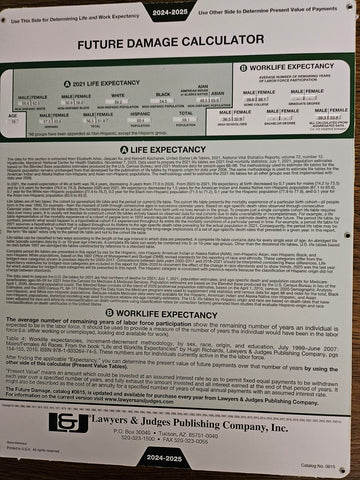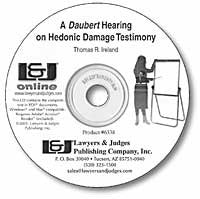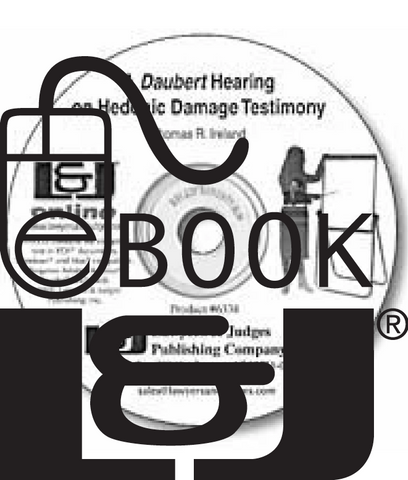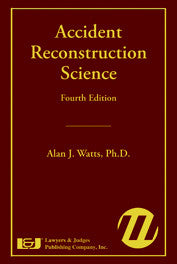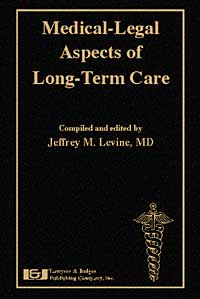
Medical-Legal Aspects of Long-Term Care
- Editor: Jeffrey M. Levine; Contributors: Faerella Boczko, Victoria Hammer Castellanos, Nancy Collins, Fred Feinsod, Carlos Rojas-Fernandez, Thomas Haas, Karen Josephson, Marshall B. Kapp, Samuel W. Kidder, Jeffery M. Levine, Jill Loeb, Duncan S. MacLean, Vincent Marchello, Steven Miles, Lorraine C. Mion, Laurence Z. Rubenstein, Andrew Weinberg, Ruth West
- ISBN 10: 1-930056-23-0
- ISBN 13: 978-1-930056-23-7
- Copyright Date Ed: May 1, 2003
- Pages: 376 pages
- Binding Information: Hardcover
- Size: 6 ✕ 9 Inches (US)
There are currently over 1.7 million elderly persons in nursing homes in America. Because of their medical complexity, this group is prone to poor outcomes such as falls, accidents, pressure ulcers, infections and death. In recent years, damage awards by juries in negligence cases involving elderly persons have soared.
This book is designed as a reference source for attorney and lay persons interested in the topic of neglect and abuse in nursing homes. Its goal is to provide a framework for understanding when a poor outcome is a result of negligence on the part of the caregiving facility and its personnel. It provides a source of information on basic medical aspects of nursing home care, with an emphasis on topics of medical-legal importance.
TOPICS INCLUDE
- Introduction to the nursing home industry
- The survey process and the minimum data set
- Understaffing in nursing homes: Causes, consequences and cures
- Dementia and dysphagia
- Pain management; adverse drug events
- Nutrition and hydration
- Wound care
- Psychopharmacolgic medication
- Falls and fall-related injuries
- Bed safety and physical restraints
- Physical abuse and neglect
- Effective risk management
- The role of private accreditation
This book is also available as an E-book. Click here to purchase and download:
Table of Contents
Acknowledgments
Conventions Regarding Medications
Foreword
Marshall B. Kapp, JD, MPH, FCLM
Chapter 1: Introduction to the Nursing Home Industry
Jeffrey M. Levine, MD
1.1 Introduction and Scope of This Book
1.2 Historical Considerations
1.3 Demographic Issues
1.4 The Spectrum of Long-Term Care
1.5 The Nursing Home Resident
1.6 Services Provided by the Nursing Home
1.7 Certification and Ownership
1.8 Economic Issues
1.9 An Industry in Crisis
1.10 Conclusions
Endnotes
Chapter 2: The Survey Process
Ruth West, RN, BS
2.1 The Federal Survey Process
2.2 Types of Surveys
2.3 Survey Tasks
2.4 The Statement of Deficiencies
2.5 The Plan of Correction
A. Immediate corrective action
B. Identification of other residents who may have been affected by the deficient practice
C. Systemic changes
D. Quality assurance monitoring
2.6 Enforcement Actions
A. Category one remedies
B. Category two remedies
C. Category three remedies
Endnotes
Chapter 3: Resident Assessment and Care Planning
Duncan S. MacLean, MD, CMD and Jeffrey M. Levine, MD
3.1 Overview of the Resident Assessment Instrument (RAI)
A. In general
B. Historical origins
C. Conceptual models
D. Statutory basis for the RAI in nursing facilities
E. Participants in the assessment process and sources of information
3.2 Content of the RAI for Nursing Facilities
A. Minimum Data Set (MDS) Version 2.0
B. Resident Assessment Protocols (RAPs)
C. Utilization Guidelines
3.3 The Assessment Schedule for the RAI
A. Regular assessment schedule
B. Significant change in status assessment (SCSA)
3.4 Linking the Assessment to the Care Plan
3.5 Additional Uses of the Minimum Data Set
A. Medicare and Medicaid payment systems
B. Monitoring the quality of care
Endnotes
Chapter 4: Understaffing in Nursing Homes: Causes, Consequences and Cures
Jeffrey M. Levine, MD
4.1 Introduction
4.2 Institutional Policies to Keep Costs Down
4.3 Understaffing of the Nursing Department
A. In general
B. The effect of understaffing on basic care
C. The effect of understaffing on complex care
4.4 Understaffing of Other Clinical Personnel
4.5 The Effect of Understaffed Support Personnel
4.6 Approaches to Improve Staffing
A. Legislation of minimum nurse staffing standards
B. The view of consumer advocacy organizations
C. Industry initiatives
4.7 Summary and Conclusions
Endnotes
Chapter 5: Dementia Care
Vincent Marchello, MD
5.1 Introduction
5.2 Evaluation of Dementia
5.3 Specific Dementing Diseases
A. Alzheimer's disease (AD)
B. Multi-infarct dementia (MID)
C. Frontotemporal dementias (FTD)
D. Metabolic and toxic dementias
E. Other dementias
5.4 Treatment of Dementia
A. Medications
B. Behavior management
C. Alzheimer's special care units (SCU)
5.5 Staging and Survival
Endnotes
Chapter 6: Pain Management
Jill L. Loeb, BSN, RN
6.1 Introduction
6.2 An Emerging Standard
6.3 Pain Assessment Is Key
6.4 Pharmacologic Interventions
A. Non-opioid analgesics
B. Opioid analgesics
C. Adjuvant analgesics
D. The analgesic ladder
E. Potentially inappropriate medications
6.5 Nonpharmacologic Interventions
6.6 Key Concepts in Pain Management
6.7 Regulatory Environment and Accreditation
6.8 Conclusions
Endnote
Chapter 7: Nutrition and Hydration
Nancy Collins, PhD, RD, LD/N and Victoria Castellanos PhD, RD
7.1 Introduction
7.2 Nutrition Care Professionals
A. Registered dietitian (RD)
B. Dietetic technician, registered (DTR)
C. Certified dietary manager (CDM)
D. Licensed nurses and certified nursing assistants
E. Speech pathologist
7.3 Timeline for Nutritional Assessment
7.4 Assessment and Provision of Nutrition
A. Determining calorie and protein needs
B. Meeting calorie and protein needs
7.5 Assessment and Provision of Fluids
A. Determining fluid needs
B. Meeting fluid needs
7.6 Documentation of Food and Fluid Intake
7.7 Involuntary Weight Loss (IWL)
A. Increasing food intake
B. Pharmacologic interventions for weight gain
7.8 Tube Feedings
Endnotes
Chapter 8: Dysphagia
Faerella Boczko, MS, CCC/SLP
8.1 Introduction
8.2 The Normal Swallowing Process
8.3 Causes of Swallowing Disorders
8.4 Medication Affecting Swallowing
8.5 Signs and Symptoms of Dysphagia
8.6 The Clinical Bedside Examination
8.7 Diagnostic Studies
8.8 Speech and Language Pathology Interventions
8.9 Adaptive Equipment
8.10 Swallowing and Dementia
8.11 Tube Feeding and Ethical Issues
Endnotes
Chapter 9: Wound Care
Jeffrey M. Levine, MD
9.1 Introduction
9.2 Pressure Ulcers
A. In general
B. Pressure ulcer prevention
C. Complications of pressure ulcers
9.3 Other Types of Wounds
A. Peripheral vascular disease (PVD) ulcers
B. Diabetic ulcers
C. Surgical wounds
D. Cancer-related wounds
E. Other wounds
9.4 Wound Care in the Nursing Home
9.5 Avoidable versus Unavoidable Ulcers
9.6 Determination of Neglect
A. Wound documentation
B. Nutritional assessments
C. Wound-care orders
D. Treatment records
E. Minimum Data Sets (MDS) and care plans
9.7 Summary
Endnotes
Chapter 10: Adverse Drug Events
Carlos Rojas-Fernandez, PharmD
10.1 Introduction
10.2 Epidemiology of Adverse Drug Events in the Nursing Home
10.3 Sequence of Events in Prescribing Medications
10.4 Side Effects and Allergies
10.5 Drug Interactions
10.6 Adverse Events Associated with Drug Withdrawal
10.7 Establishing Causality
10.8 Factors that Predispose Residents to Adverse Drug Events
A. Polypharmacy
B. Metabolic changes associated with aging
C. Medication errors
D. Inappropriate prescribing of medication
E. Special considerations in the nursing home
10.9 OBRA Regulations Relevant to Adverse Drug Events
10.10 Conclusions
Endnotes
Chapter 11: Psychopharmacologic Medications
Samuel W. Kidder, PharmD, MPH
11.1 Introduction
11.2 Federal Regulation of Psychopharmacologics: The OBRA '87 Provision
A. Use of the term ∏chemical restraint∑
B. Antipsychotic drugs: Indications for use
C. Antipsychotic drugs: Gradual dose reductions
D. Unnecessary drugs
11.3 Specific Psychopharmacologic Medications
A. Antipsychotic medications
1. ∏Conventional∑ antipsychotic medications
2. Common ADEs of conventional antipsychotic medications
3. ∏Atypical∑ antipsychotic medications
B. Antidepressant medications
C. Antianxiety medications (also called anxiolytic medications)
D. Hypnotic medications
11.4 Implications for the Future
Endnotes
Chapter 12: Falls and Fall-Related Injuries
Laurence Z. Rubenstein, MD, MPH, and Karen R. Josephson, MPH
12.1 Introduction
12.2 Epidemiology
A. Incidence of falls
B. Fall-related injuries and mortality
12.3 Causes and Risk Factors for Falls
12.4 Fall Prevention in the Nursing Home
A. Assessment
B. Fall prevention interventions
C. Muscle weakness and impaired function
D. Gait and balance impairments
E. Dizziness syndromes
F. Postural hypotension
G. Polypharmacy and inappropriate medications
12.5 Institution-Wide Fall Prevention
A. Environmental assessment
B. Nursing interventions
C. Fall- and injury-prevention devices
12.6 Conclusion
Endnotes
Chapter 13: Physical Restraints
Lorraine C. Mion, PhD, RN
13.1 Introduction
13.2 Regulatory Definitions
13.3 Types of Physical Restraint
13.4 Rationale for Physical Restraint Use
13.5 Adverse Effects of Restraint Use
13.6 Regulatory Requirements for Physical Restraints
13.7 Risks of Liability
13.8 The Process of Restraint Minimization
A. General considerations
B. Interventions to manage wandering
C. Interventions for agitation and disruptive behavior
D. Interventions for maintaining therapeutic devices
13.9 Summary
Endnotes
Chapter 14: Bed Safety
Fred M. Feinsod, MD, MPH, CMD and Steven H. Miles, MD
14.1 Introduction
14.2 The Decline of Using Bedrails for Safety
14.3 Bed Safety without Restraints
14.4 Alternatives to Bedrails
14.5 Limited Uses for Bedrails
14.6 Conclusions
Endnotes
Chapter 15: Physical Abuse and Neglect
Duncan S. MacLean, MD, CMD
15.1 Introduction
15.2 Definitions and Classification of Mistreatment
15.3 Comparison between Domestic and Institutional Mistreatment
15.4 Epidemiology of Abuse and Neglect
15.5 Clinical Features
15.6 Natural and Accidental Causes of Bad Outcomes
A. Spontaneous osteoporotic fractures
B. Dementia-associated weight loss
C. Dementia-associated functional decline
D. Contractures from severe spasticity or dementia
E. Immobility from advanced heart, lung or arthritic disease
F. Fall-related injuries despite adequate fall-prevention care plans
G. Resident-to-resident accidents
H. Unavoidable pressure ulcers
I. Senile purpura
J. Adverse drug events
K. Death
L. Post hoc ergo propter hoc
15.7 Dynamics of Institutional Abuse and Neglect
A. Physical abuse
B. Neglect
15.8 Prevention and Risk Management
A. Anti-abuse policies
1. Prevention policies and procedures
2. Screening of potential hires
3. Training of employees
4. Identification of possible incidents or allegations that need investigation
5. Investigation of incidents and allegations
6. Protection of residents during investigations
7. Reporting of incidents, investigations, and the facility's response to the results of their investigations
B. Additional administrative measures
1. Monitoring indicator trends
2. Reviewing indicator trends with the medical director
3. Reporting the medical director's analysis to the owner
4. Advance directives and end-of-life care
5. Restraint management
6. Behavior management
7. Attending physician documentation
C. Corporate compliance programs
15.9 Documentation and Reporting
A. Documentation
B. Reporting
C. Special considerations
15.10 Summary
Endnotes
Chapter 16: Effective Risk Management
Andrew D. Weinberg, MD, FACP
16.1 Introduction
16.2 Risk Management for Physicians and Medical Directors
16.3 Risk Management for Nurses
16.4 Documentation and Charting
16.5 Recommendations for Nursing Homes
16.6 Sample Issue: Elopement
16.7 Summary
Endnotes
Chapter 17: The Role of Private Accreditation
Thomas Haas, MS, RNC, LNHA
17.1 Private Accreditation Organizations
17.2 The Accreditation Process
17.3 State Survey and JCAHO Survey Compared
17.4 Continuous Updating of Standards
17.5 JCAHO Accreditation Decision Categories
17.6 Conclusions
References
About the Editor
About the Contributors
Index

